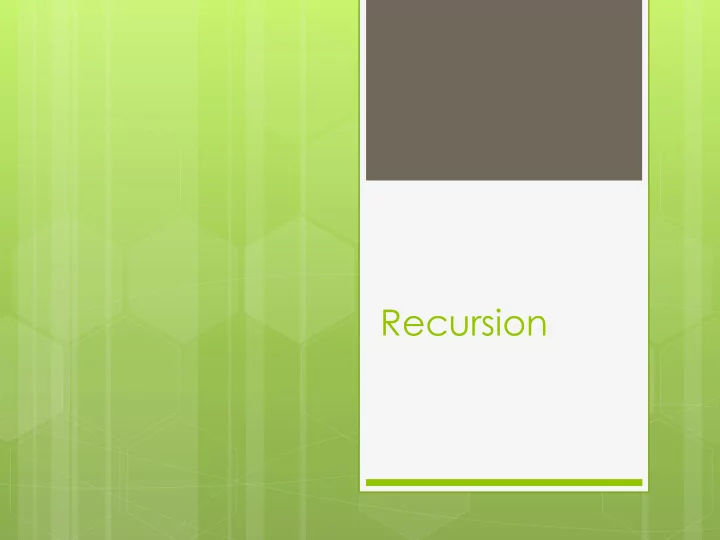

Recursion
Suppose You Are Waiting in L ine… HI YOU!
… A Very Long Line
You want to determine how many people are in front of you, but you cannot see and you’re not allowed to move . You are only allowed to speak to the person in front of you and behind you . How do you do it?
Recursion A programming technique that breaks down a complex problem into smaller, manageable pieces Recursive solutions solve a problem by applying the same algorithm to each piece and then combining the results.
The General Formula #people in front of person in front of you + person in front of you = # people in front of you
The Solution Tap the shoulder of the person in front of 1. you and ask how many people are in front of him/her Wait for his/her response and add 1 2. If someone asked, tell them how many 1. people are in front of you
A Diagram Ask and wait Ask and wait Ask and wait…. …. Reached first in line. Tell person behind it is 0. Tell person behind it is 0+1 Tell person behind it is 1+1… Tell Person behind it is x +1
Recursive Algorithms There are two main components to recursive algorithms 1) Base Case 2) The Recursive Case
Recursive Algorithms There are two main components to recursive algorithms 1) Base Case: The point where you stop applying the recursive case 2) Recursive Case: The set of instructions that will be used over and over
In the Queue Problem… Recursive case is Tap person in front of you. Ask #people in front of him. Wait for his answer and add 1. Base case is person 0. You do not do execute the above.
Recursion and Programming A recursive function is a function that calls itself numberOfPeopleInFront(person){ If (there is no one to tap) return 0 Else tap person in front of you (F) #ppl in front of F = numberOfPeopleInFront(F) return #ppl in front of F + 1 }
Pseudo-code diagram Ask and wait Ask and wait Ask and wait…. …. Reached first in line. Return 0. Return 0+1 Return 1+1… Return x +1
Towers of Hanoi A prominent recursive problem Starting Configuration: Goal: Move tower from A to B
Rules Move one disk at a time A larger disk cannot be placed on top of a smaller disk We can use some needles as temporary storage
Subgoals Get top x-1 disks from A to C Get bottom disk from A to B Move top x-1 disks from C to B
Recursion Behind Towers Base Case: Moving the Largest Disk to Needle B Recursive Case: Do same for the x – 1 disk above it http://www.mazeworks.com/hanoi/ Fun Fact: It takes at least 2 n -1 moves to solve the puzzle
Fractals A rough or fragmented geometric shape that can be split into parts, each of which is (at least an approx. of) a reduced copy of the whole Base case: Starting shape Recursive case: Repeating shape in different sizes Koch Snowflake
Recommend
More recommend